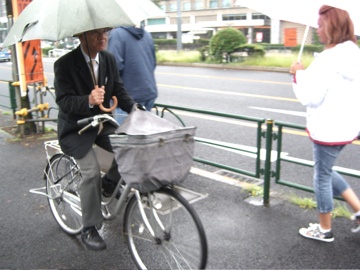
Once upon a time, the Bay Area Rapid Transit district required bicyclists to obtain a permit to ride its trains. You could get the permit by schlepping down to BART’s Lake Merritt station, or you could obtain it by mail. Our recollection is that you had to sign some paperwork stating you understood BART’s bike rules–most notably, to our mind, NO BIKES ON STATION ESCALATORS OR ON THE FIRST CAR OF TRAINS–and agreed to abide by them. Those were the days before the still-unfolding Cycling Enlightenment. Some years ago, BART dropped the permit requirement and pretty much welcomed all two-wheeled comers as long as they STAY OFF THE ESCALATORS AND PLEASE SIR WITH THE BIKE IN THE FIRST CAR MOVE TO ANY OTHER CAR ON THE TRAIN.
In theory, it’s swell to be able to travel with one’s velocipede on the BART system. Many’s the time we’ve ended rides at the far-off Dublin/Pleasanton and Fremont stations and taken the train back home. BART also provides a way of getting across the watery impediment known to locals as The San Francisco Bay. It’s not the only way of course–you can get a bike shuttle (a trailer service that hauls bikes across the Bay Bridge), take AC Transit (which has front-mounted bike racks), or, best of all, take the ferry. But BART is the most available option.
In practice, we’ve found the trains to be less than ideal for traveling from the East Bay to the city or back. The main reason is that the cars just aren’t designed to accommodate full-sized two-wheeled machines. If one sits, one almost by necessity takes up two seats. Not a big deal if it’s not a busy time of day; if it is, then taking the extra seat seems a little inconsiderate (this is a sermon delivered from the perspective of an offender).
The bigger problem with bikes on BART is that so many of the cyclists who bring their two-wheelers on the trains appear so lacking in care or respect for other passengers. For instance: If you’ve ridden the system at all, you can anticipate which door on the cars will open at which stations. But it’s common to see cyclists crowd their bikes into the exit door and block it when they have no intention of exiting (oh, sure, we see other passengers doing this too; we just expect cyclists to exhibit a little less lameness than the dopiest rapid-transit rider). It’s also typical to see riders station their machines in the aisles without regard to how it affects other passengers.
Take the specimen above (at left), photographed on a recent Sunday. He parked his bike in the exit door and for bonus points positioned it most of the way across the aisle. When someone sat opposite him, it was just possible for other passengers to squeeze by. He situated himself thus even though several other seats were available that would have allowed him to stay out of the way. After planting his rear end in his seat, he either affected obliviousness (or actually was oblivious) to all around him.
Part of the problem is that BART cars aren’t designed to accommodate bikes in the first place. A few have been refurbished with a sign that says “bike space.” But if more than a couple passengers bring their bicycles on board, the usual awkwardness ensues. Seeing that the physical space isn’t quite fit for bikes and passengers to co-exist, something’s got to give. The change has got to happen in the social space. Cyclists on BART need to be attentive to how their presence affects other passengers; just as attentive as they want the rest of the world to be to them and their needs.




